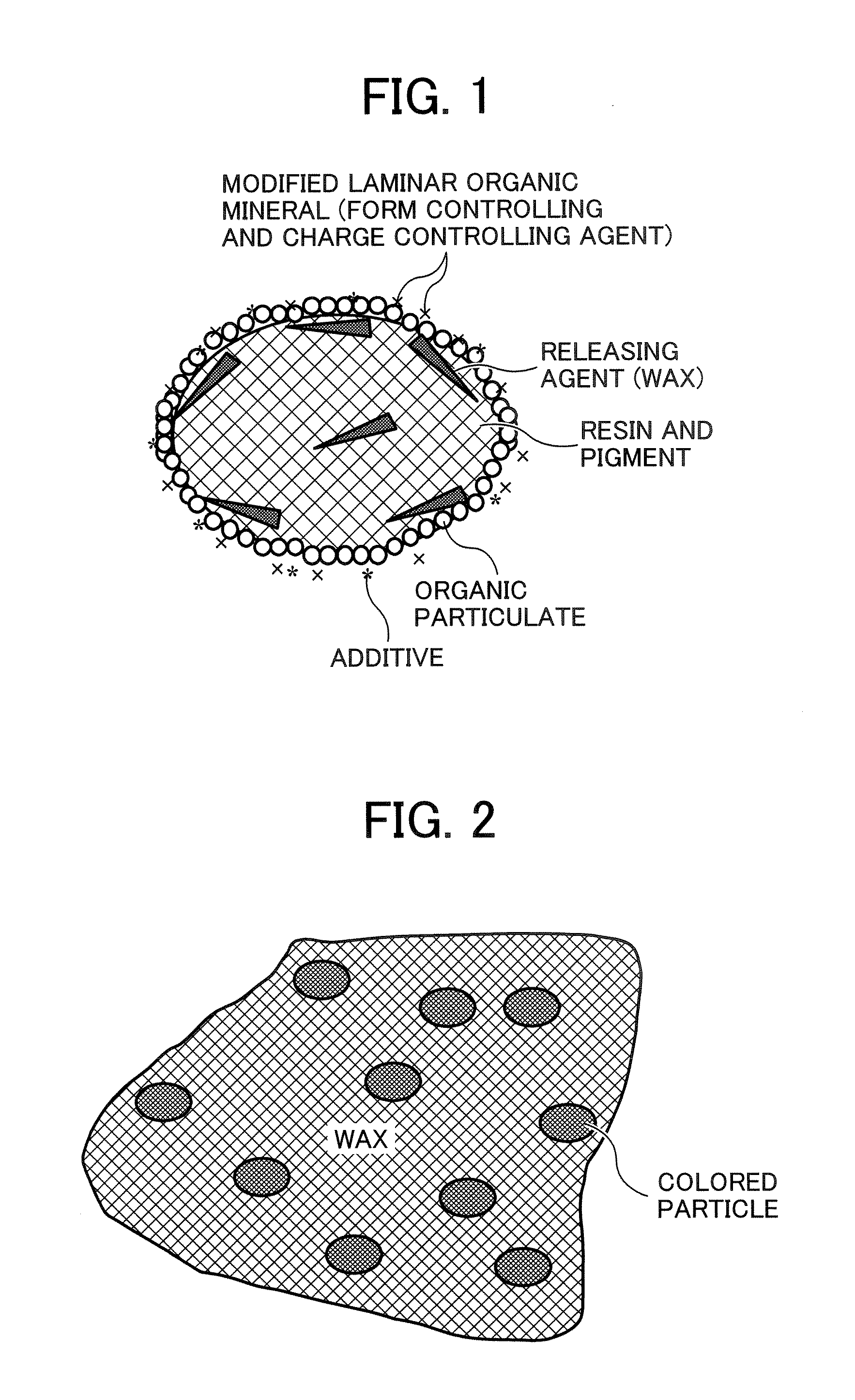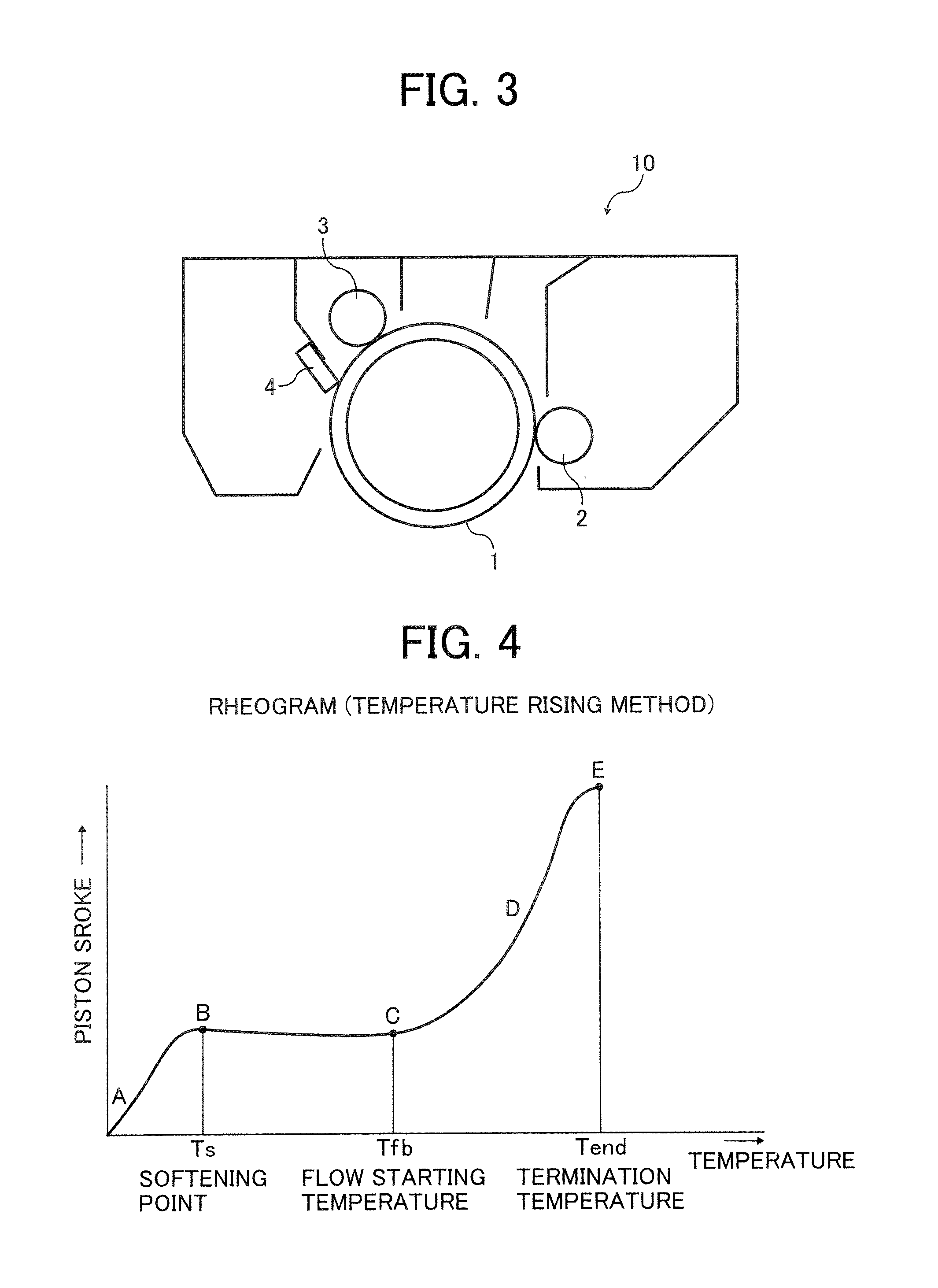Toner and method of manufacturing the same
a technology of toner and halftone, applied in the field of toner, can solve the problems of deterioration of the fixing property of such a toner in the halftone portion formed thereof, easy high temperature offset phenomena, and relatively large problems of high-speed fixing about toner, and achieve good low-temperature fixing properties, excellent fluidity, and reduced size
- Summary
- Abstract
- Description
- Claims
- Application Information
AI Technical Summary
Benefits of technology
Problems solved by technology
Method used
Image
Examples
example 1
Synthesis of Emulsion of Organic Particulates
manufacturing example 1
[0224] The following recipe is placed in a reaction container equipped with a stirrer and a thermometer and the mixture is agitated for 15 minutes at a revolution of 400 rpm to obtain a white emulsion.
Water780partsSodium salt of sulfate of an adduct of methacrylic acid with11partsethyleneoxide (EREMINOR RS-30 manufactured by SanyoChemical Industries Ltd.)Styrene90partsMethacrylic acid90partsButyl acrylate120partsAmmonium persulfate1part
[0225] The emulsion is heated at 75° C. to conduct a reaction for 5 hours. Then, 30 parts of a 1% aqueous solution of ammonium persulfate are added to the emulsion and the mixture is further aged for 5 hours at 75° C. Thus, an aqueous liquid dispersion (Particulate liquid dispersion 1) of a vinyl based cross-linking resin (i.e., a copolymer of styrene, methacrylic acid, and butyl acrylate) is obtained. The volume average particle diameter of Particulate liquid dispersion 1 is 50 nm when measured by LA-920.
[0226] Particulate liquid dispersion 2 is p...
manufacturing example 3
[0232] Eighty five (85) parts of a binder resin (polyester resin: formed of adduct of Bisphenol A with propylene oxide succinic acid derivative, manufactured by Sanyo Chemical Industries Ltd., acid value: 10, Tg: 52° C.) is mixed and kneaded for 15 minutes by a two-roll with a setting of the roll surface temperature of 110° C. and the roll gap of 2 mm. Then, 10 parts of modified montmorillonite (Clayton APA, manufactured by Wilbur-Ellis Co., Ltd.) are placed into the polyester resin, kneaded for 30 minutes and cooled down to room temperature. The resultant is pulverized by a pulverizer to a size of 2 mm φ to obtain Modified laminar inorganic mineral dispersion body 2.
Preparation of Aqueous Phase
PUM
| Property | Measurement | Unit |
|---|---|---|
| Temperature | aaaaa | aaaaa |
| Temperature | aaaaa | aaaaa |
| Temperature | aaaaa | aaaaa |
Abstract
Description
Claims
Application Information
 Login to View More
Login to View More - R&D
- Intellectual Property
- Life Sciences
- Materials
- Tech Scout
- Unparalleled Data Quality
- Higher Quality Content
- 60% Fewer Hallucinations
Browse by: Latest US Patents, China's latest patents, Technical Efficacy Thesaurus, Application Domain, Technology Topic, Popular Technical Reports.
© 2025 PatSnap. All rights reserved.Legal|Privacy policy|Modern Slavery Act Transparency Statement|Sitemap|About US| Contact US: help@patsnap.com



